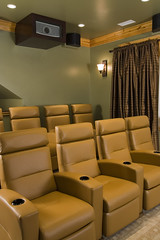AFTER LIVING IN MOSCOW for several years, Italian photographer Davide Monteleone became interested in the Northern Caucasus--the mountainous, geopolitically complex region between the Caspian and Black Seas that is home to a wide range of ethnic groups, many of them Muslim--because the culture, landscape and people were so different from those in Slavic Russia, which controls many of the areas.
Having moved to Russia during the Second Chechen War, which was fought from 1999 to 2008, Monteleone knew about the Caucasus region and the Russian republic of Chechnya primarily through media reports of terrorist attacks, human rights violations and other atrocities associated with the conflicts there. "What about regular people living there?" he wondered. "For every work that I do, I want to show the daily life of people," Monteleone explains. "Then of course I try to get a little bit deeper and try to find my own vision, but it's my curiosity first of all."
[ILLUSTRATION OMITTED]
[ILLUSTRATION OMITTED]
In 2007 he went to work exploring the culture of Chechnya and its neighboring republics, including Abkhazia (the Georgian Republic), Dagestan, Ingushetia, Karachay-Cherkessia, Kabardino-Balkaria, North Ossetia and the disputed territory of South Ossetia.
Since then Monteleone has spent several years photographing in the Caucasus, and his images of the daily lives and traditions of peoples living in the region have been widely recognized. He received an Emerging Photographer Grant from the online magazine Burn in 2010 and an Aftermath Project Grant in 2011. Also in 2011, Monteleone won the European Publishers Award for his work, and the resulting book, feed Thistle, will be released this month in English by Dewi Lewis Publishing, and by four other publishers in different languages.
Despite the recent wars in the region and a history of conflict that stretches back centuries, Monteleone found the people of the Caucasus friendly and hospitable, willing to invite him into their lives. At times Monteleone was frustrated trying to make photographs of the people he met because their stories were "so strong," he says. He remembers sitting with one woman for several hours. "If you heard a mother telling you that she lost four kids in the same morning because the federal army arrived and decided to destroy the village, because one of the supposed terrorists was there, what can you do with the picture?" he explains. "You take the portrait of her and you think, 'It's not enough.'"
Monteleone worked in the region with the journalist Lucia Sgueglia, who contributed several essays to the book. Working with a writer was important, Monteleone says, because she saw things differently and helped him open his mind to different ways of conveying what he was seeing.
In Monteleone's images we see a woman walking near a large river of blood from a bull sacrifice in Dagestan. We see a bride in Ingushetia wearing a traditional gown and veil. A Georgian woman lies on her bed in the days following a bombing in her city. Another woman celebrates Russia's recognition of South Ossetia as a sovereign state in 2008 by holding a flag aloft in the wind. An Abkhazian militiaman patrols a wooded area in the Kodori Valley. The wall of a secondary school in North Ossetia is hung with a grid of photographs of children killed in a 2004 terrorist attack.
If the people in the Caucasus were hospitable, "the authorities were not," Monteleone says. As a result, a majority of his images had to be made indoors--in houses, other buildings or cars. The closeness of the images reflects one of the conflicts of the Caucasus, Monteleone says. "You have this wild, big [landscape], and at the same time the people are sort of afraid of moving, they cannot reach some places. A lot of areas are closed because of antiterrorist operations, you cannot go to the mountains because it's forbidden because of military operations ... [The people] are restricted in a way, in the mind and physically."
[ILLUSTRATION OMITTED]
Expressing through photographs how a conflict continues to affect a population after it has ended is more difficult than photographing a war or protest or concrete event, Monteleone says, but he considers telling this type of story "the new frontier of documentary photography."
In editing the project, Monteleone chose images that were direct and "concerned about a person specifically," as well as images that were "metaphors for a more general story," he says.
Monteleone believes the recognition he's received reflects his commitment to the subject, the fact that "the narrative [of daily life in the Caucasus] has not been covered," and that his images are esthetically accomplished.
The most important result for him, however, is that the work makes viewers curious. "I don't think photography has to explain or give an answer about something, especially nowadays," Monteleone explains. "It's possible to find information about every corner in the world really easily. Maybe the use of photography now is not only to inform but more to make people curious." The best compliment he received for his previous book, Dusha Russian Soul, which was about Russia, was when someone told him the book made them want to visit for themselves.
"I just give you the first key," Monteleone says. "Then you can try to open every door that you like."
EDITED BY CONOR RISCH
Do you have an interesting photography project? Contact section editor Conor Risch at PDN, 770 Broadway, 8th floor, New York, NY 1o003 or e-mail conor.risch@nielsen.com.
Risch, Conor
Source Citation
Risch, Conor. "Disputed territories: Davide Monteleone's new book, Red Thistle, explores daily life in the Northern Caucasus, a region of hospitable people scarred by a history of conflict." Photo District News May 2012: 98+. Communications and Mass Media Collection. Web. 24 Apr. 2012.
Document URL
http://go.galegroup.com/ps/i.do?id=GALE%7CA286719132&v=2.1&u=22054_acld&it=r&p=PPCM&sw=w
Gale Document Number: GALE|A286719132


No comments:
Post a Comment